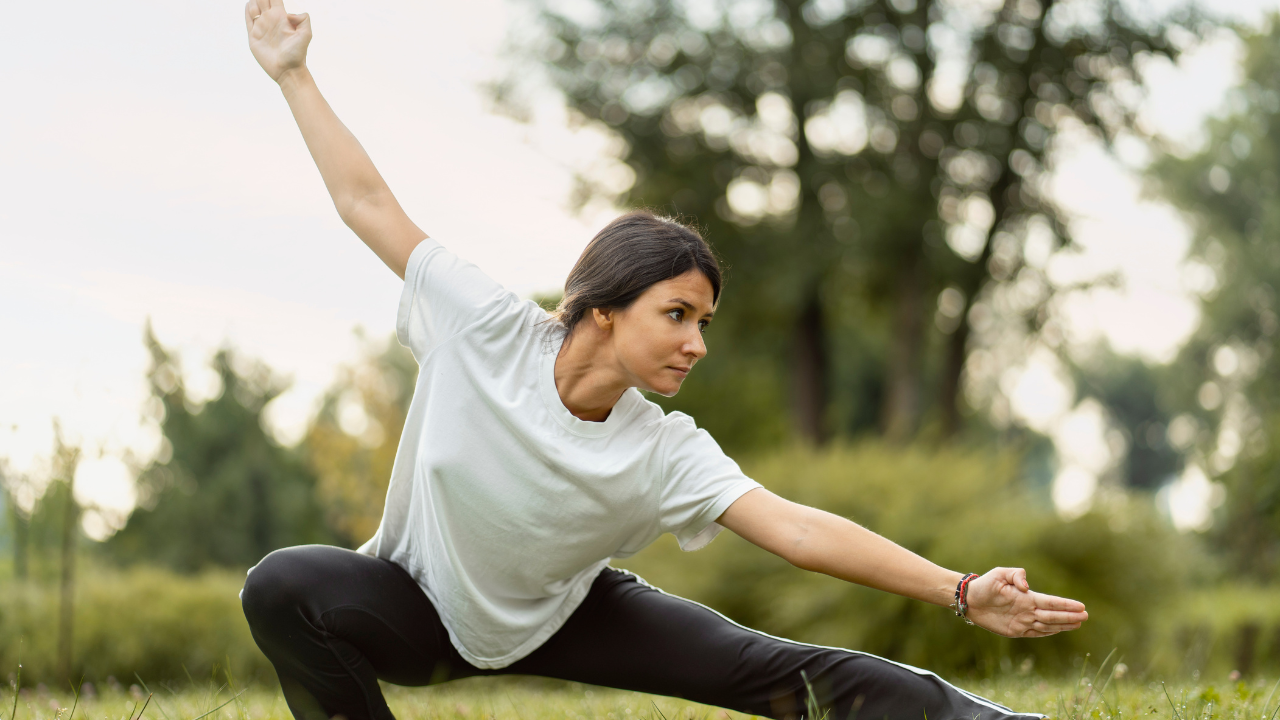Fitness
New Study Reveals Which Exercise Can Significantly Improve Parkinson’s Symptoms

- Tai chi is a form of martial arts that focuses on slow and gentle movements paired with breathing exercises.
- New research suggests that long-term tai chi practice may improve symptoms and reduce complications in individuals with Parkinson’s disease.
- Not only is tai chi easy to start, but it is suitable for all fitness levels and can benefit people with certain chronic diseases.
An ancient martial art that originated in China, tai chi is a low-impact form of exercise that focuses on slow and gentle movements paired with controlled breathing. The practice boasts over 250 million practitioners around the world, and has been associated with helping manage stress, improve balance and combat pain related to lower-back issues, fibromyalgia and knee osteoarthritis. But its benefits may also include helping people with major chronic diseases. New research showed promising results related to practicing long-term tai chi and Parkinson’s disease.
The study, published in the Journal of Neurology, Neurosurgery and Psychiatry, looked at two groups – one group of about 143 patients with Parkinson’s disease and active tai chi training, and another control group of 187 Parkinson’s’ disease patients with no exercise. The participants were assessed routinely over the course of 3.5 years. The results found tai chi to have a long-term beneficial effect on Parkinson’s disease, with improvements in symptoms and a reduction in complications. Tai chi training also delayed the need for increasing anti-Parkinson’s therapies.
But this isn’t the first time that tai chi has shown promise with Parkinson’s disease. Prior research, including a review in 2021, showed that regular tai chi sessions had a positive effect similar to that of other exercise therapies like dancing and aerobic exercise. Additional findings have shown that practicing tai chi may be helpful for people with other chronic diseases including chronic obstructive pulmonary disease (COPD), type 2 diabetes and heart disease.
How long does it take to learn tai chi?
There are 108 movements in tai chi that are paired with breathing exercises to connect the mind and body during the practice. You’ll often start with just a few movements and slowly work your way up from there. Your dedication to the practice and frequency and duration of sessions are all factors that will determine how long it will take you to learn tai chi, but it can take about 30 sessions to learn the basic movements.
Is tai chi good for beginners and seniors?
Tai chi is a great option for beginners because it requires no special equipment or expertise to start. It’s not as strenuous as other forms of exercise, so any fitness level and nearly any age can participate in it. Plus, given its well-researched health benefits, it is generally considered to be safe for people with different medical issues including heart disease and COPD. Some research has even found that tai chi may prevent falls and improve balance in older individuals.
All you’ll need is some comfortable clothes, sneakers and a bottle of water for your tai chi session. You can find a class near you, or even search for a virtual session or video on your phone or computer. Find some open space either inside or outdoors and follow along with the routine to practice the movements. If you stick with it for a few weeks, you’ll start to reap the wonderful mind and body benefits of a regular tai chi practice.
The bottom line: Tai chi is a low-impact form of exercise that is beginner-friendly and safe for most populations. Prior studies have linked a regular tai chi practice with reducing stress, improving balance, managing pain and benefitting individuals with certain chronic diseases. New research shows that long-term tai chi practice can improve symptoms and reduce complications in individuals with Parkinson’s disease. You can find tai chi classes near you or search for a tai chi instructional video online to get started.
Nutrition Lab Director
Stefani (she/her) is a registered dietitian, a NASM-certified personal trainer and the director of the Good Housekeeping Institute Nutrition Lab, where she handles all nutrition-related content, testing and evaluation. She holds a bachelor’s degree in nutritional sciences from Pennsylvania State University and a master’s degree in clinical nutrition from NYU. She is also Good Housekeeping’s on-staff fitness and exercise expert. Stefani is dedicated to providing readers with evidence-based content to encourage informed food choices and healthy living. She is an avid CrossFitter and a passionate home cook who loves spending time with her big fit Greek family.

Fitness
This Workout Program Will Help You Shred Your Dad Bod

BALANCING FATHERHOOD AND FITNESS has never been easy. You’ve got less time, less sleep, and less mental bandwidth. Most workouts just aren’t made for the daily grind dads face. Until now.
That’s because now you can follow the program that’s kept one of the fitness world’s most shredded trainers ripped while raising four kids. Meet Dad Bod Shred, your new go-to video workout program built just for busy dads by 46-year-old Cory Gregory.
Gregory is in the best shape of his life. And he’s gotten here by overcoming his own daddyhood challenges. Like plenty of dads, Gregory’s beaten injuries, battling back from a torn rotator cuff to bench press more than 300 pounds. He’s also learned to maximize his gym time, developing a system of muscle-building sessions that can have him in and out of the gym in less than 45 minutes.
He’s sharing those secrets with you in Dad Bod Shred, which includes five 30-minute muscle-building workouts, one quick cardio session, and countless hacks that can help busy dads everywhere get jacked in less than an hour a day.
The program is available exclusively to Men’s Health MVP Premium members, so if you’re not already a member, sign up NOW!
Your Coach
CORY GREGORY, who’s better known as CoryG, is a veteran fitness trainer and influencer who’s worked with celebrities and powerlifters alike. But he’s more than that too. A father of four, he’s a savvy presence who understands how to build muscle and strength without spending hours in the gym.
His secret: A unique brand of training that incorporates supersets and limited rest times to push your muscles to the limit even if you aren’t lifting titanic loads. This helps minimize injury while still setting you up for the gains you’ve always wanted.
Your 4-Week Dad Bod Shred Schedule
You can tackle these five workouts any way you want, but for best results, follow the 4-week schedule below; it’ll insure you’re pushing your limits five days a week.
Week 1
SUNDAY: REST
MONDAY: LEGS
TUESDAY: ARMS, 10-MINUTE CARDIO
WEDNESDAY: BACK
THURSDAY: REST/10-MINUTE CARDIO
FRIDAY: CHEST
SATURDAY: SHOULDERS, 10-MINUTE CARDIO
Week 2
SUNDAY: REST
MONDAY: LEGS
TUESDAY: ARMS, 10-MINUTE CARDIO
WEDNESDAY: BACK
THURSDAY: REST/10-MINUTE CARDIO
FRIDAY: CHEST
SATURDAY: SHOULDERS, 10-MINUTE CARDIO
Week 3
SUNDAY: REST
MONDAY: LEGS
TUESDAY: ARMS, 10-MINUTE CARDIO
WEDNESDAY: BACK
THURSDAY: REST/10-MINUTE CARDIO
FRIDAY: CHEST
SATURDAY: SHOULDERS, 10-MINUTE CARDIO
Week 4
SUNDAY: REST
MONDAY: LEGS
TUESDAY: ARMS, 10-MINUTE CARDIO
WEDNESDAY: BACK
THURSDAY: REST/10-MINUTE CARDIO
FRIDAY: CHEST
SATURDAY: SHOULDERS, 10-MINUTE CARDIO
Join the Men’s Health Community for even more perks
MEN’S HEALTH MVP is a community of guys who are passionate about building their physical, mental, and emotional fitness, just as you are. And our MH MVP program is about giving you as many tools as possible to make that possible. Our Summer Shred program is just the start of a vast array of features that’ll help you become your best self.
- Unlock all stories and curated training plans for all fitness goals, as well as cutting-edge reviews and in-depth breakdowns of new workout principles at menshealth.com
- Get every print issue delivered straight to your mailbox
- Receive a weekly members-only newsletter with deep insights from MH’s fitness experts
- Access hundreds of streaming video workouts on demand
JOIN MVP PREMIUM
Photographs by Justin Steele.
Fitness
Just one session of exercise can keep your brain supercharged till the next day – Times of India

A lot is being said about physical activity these days. The impact of physical inactivity has hit the population so terribly that health agencies have been urging people to include at least 150 minutes of exercise in their weekly routine. The effect of exercise is beyond physical benefits, it boosts cognitive health too.
A new study by researchers from the University College London has said that only one session of exercise can give memory benefits for more than 24 hours.
“Our findings suggest that the short-term memory benefits of physical activity may last longer than previously thought, possibly to the next day instead of just the few hours after exercise. Getting more sleep, particularly deep sleep, seems to add to this memory improvement,” Lead author Dr Mikaela Bloomberg (UCL Institute of Epidemiology & Health Care) has said.
What kind of exercises should we aim at doing?
“Moderate or vigorous activity means anything that gets your heart rate up – this could be brisk walking, dancing or walking up a few flights of stairs. It doesn’t have to be structured exercise,” the researcher has said.
For this study, the researchers examined 76 people aged 50 to 83 with moderate to vigorous physical activity than usual on a given day. They observed that these individuals did better in memory tests the day after. They found that less sitting hours and more hours of deep sleep contributed to this. The participants wore activity trackers for eight days and took cognitive tests each day.
“The study is among the first to evaluate next-day cognitive performance using a “micro-longitudinal” study design where participants were tracked going about their normal lives rather than having to stay in a lab,” the University has said.
The findings of the study have been published in the International Journal of Behavioral Nutrition and Physical Activity.
Fitness
Plod and Pedal: Missoula exercise group getting you outside every single day

MISSOULA — As the new year nears, so do resolutions.
For those looking to dedicate themselves to fitness, a Missoula group gets you running or biking every day. No exceptions or you’re out.
MTN met with the founders of Plod and Pedal to learn the purpose behind the project.
After a holiday challenge got them moving, in 2018, coworkers Ryan Mellem and Josh Pierce decided to run outside every single day.
“I’m like, we should try to run 1 mile a day, every day for the entire year. And he’s like, really?” Pierce detailed.
For the first year, they got some other co-workers in on the plan.
“Started talking about it with other people and they’re like, well, I would do that,” noted Pierce.
Everyone anteed up $20 and there was one rule, if you miss a day you lose the chance at the prize pot. “You miss a day, you’re out,” said Pierce.
Five years later, Plod and Pedal is running strong and the person with the most miles takes home the prize.
Mellem explained, “There have been some people that have done one discipline every year since then. We’ve had multiple people that have stayed in it the whole time.”
The rules are: sign up on Plod and Pedal’s website, start on New Year’s Day, run a mile in under 15 minutes, or bike 3 miles outside each day, and if you miss a day then you’re out until the next year.
171 participants started 2024. As of November, the total is down to 105.
“Since 2018, I’ve run outside every single day. At this point, it’s not a decision, it’s just what am I going to put on to do it,” stated Pierce.
For many in the group, some hailing from around the country and some across the world, they feel being able to move is a gift that shouldn’t be wasted.
“You get the body for a certain period of time and it’s nice to use it. We’ve all done things that we never thought were possible before,” offered Mellem.
Plus, the Plod and Pedal founders are passing on the gift of exercise to the next generation.
“So, allowing our 3-year-olds to go for a run with us, and keep it under that 15 minutes, was a huge part. And even to this day, they’re like, have you ran your mile yet?” Pierce told MTN
To learn more about Plod and Pedal or sign up, click here.
-
/cdn.vox-cdn.com/uploads/chorus_asset/file/24924653/236780_Google_AntiTrust_Trial_Custom_Art_CVirginia__0003_1.png)
/cdn.vox-cdn.com/uploads/chorus_asset/file/24924653/236780_Google_AntiTrust_Trial_Custom_Art_CVirginia__0003_1.png) Technology1 week ago
Technology1 week agoGoogle’s counteroffer to the government trying to break it up is unbundling Android apps
-

 News1 week ago
News1 week agoNovo Nordisk shares tumble as weight-loss drug trial data disappoints
-

 Politics1 week ago
Politics1 week agoIllegal immigrant sexually abused child in the U.S. after being removed from the country five times
-

 Entertainment1 week ago
Entertainment1 week ago'It's a little holiday gift': Inside the Weeknd's free Santa Monica show for his biggest fans
-

 Lifestyle1 week ago
Lifestyle1 week agoThink you can't dance? Get up and try these tips in our comic. We dare you!
-
/cdn.vox-cdn.com/uploads/chorus_asset/file/25672934/Metaphor_Key_Art_Horizontal.png)
/cdn.vox-cdn.com/uploads/chorus_asset/file/25672934/Metaphor_Key_Art_Horizontal.png) Technology4 days ago
Technology4 days agoThere’s a reason Metaphor: ReFantanzio’s battle music sounds as cool as it does
-

 News5 days ago
News5 days agoFrance’s new premier selects Eric Lombard as finance minister
-

 Business3 days ago
Business3 days agoOn a quest for global domination, Chinese EV makers are upending Thailand's auto industry






























